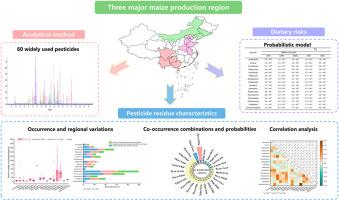Pesticide residues in maize kernels: Monitoring and human dietary risk assessment
IF 6.3
1区 农林科学
Q1 FOOD SCIENCE & TECHNOLOGY
引用次数: 0
Abstract
The protective structure of maize husks often leads to the underestimation of pesticide residues in kernels, where limited pesticide residue data pose significant challenges for effective risk management. This large-scale investigation evaluated residue levels and dietary risks of 60 representative pesticides in maize kernels from China's three major maize production regions (358 field samples). Samples were analyzed using a QuEChERS-based pretreatment method combined with ultra-performance liquid chromatography-tandem mass spectrometry (UPLC-MS/MS). Sixteen pesticides were detected, with pyraclostrobin, tebuconazole, carbendazim, triadimefon, chlorpyrifos, and fludioxonil being the most frequently detected (detection rate ≥5 %), with concentrations ranging from 1.0 to 175.9 μg/kg. Pesticide residues in maize kernels primarily originate from soil, stalks, and husks. Co-occurrence analysis revealed that 21.3 % of samples contained at least one pesticide, with up to six residues detected in a single sample. Overall, multiple pesticide co-occurrence was low, and correlations between different pesticides were weak. Probabilistic dietary risk assessment indicated that, at the 97.5th percentile exposure level, risk quotient (RQ) values ranged from 2.7 × 10−7 to 2.9 × 10−4, which were well below safety thresholds. However, pyraclostrobin, thiamethoxam, and atrazine exceeded China's maximum residue limits (MRLs) in two samples each. These findings highlight the need for continued monitoring and targeted control strategies to reduce potential dietary risks associated with pesticide residues in maize.

玉米籽粒中的农药残留:监测和人类饮食风险评估
玉米外壳的保护结构往往导致对籽粒中农药残留的低估,而有限的农药残留数据对有效的风险管理构成了重大挑战。本大规模调查评估了中国三大玉米产区(358个田间样本)60种代表性农药在玉米籽粒中的残留水平和膳食风险。采用基于quechers的预处理方法结合超高效液相色谱-串联质谱(UPLC-MS/MS)对样品进行分析。共检出16种农药,检出频率最高的农药为嘧菌酯、戊唑唑、多菌灵、三嘧菌酯、毒死蜱和嘧菌腈(检出率≥5%),浓度范围为1.0 ~ 175.9 μg/kg。玉米籽粒中的农药残留主要来源于土壤、秸秆和谷壳。共现分析显示,21.3%的样品含有至少一种农药,单个样品中检测到多达六种农药残留。总体而言,多种农药共现率较低,不同农药间相关性较弱。概率饮食风险评估表明,在97.5%暴露水平下,风险商(RQ)值在2.7 × 10−7至2.9 × 10−4之间,远低于安全阈值。然而,吡唑菌酯、噻虫嗪和阿特拉津各有两个样品超过了中国的最大残留限量(MRLs)。这些发现强调需要持续监测和有针对性的控制策略,以减少与玉米农药残留相关的潜在饮食风险。
本文章由计算机程序翻译,如有差异,请以英文原文为准。
求助全文
约1分钟内获得全文
求助全文
来源期刊

Food Control
工程技术-食品科技
CiteScore
12.20
自引率
6.70%
发文量
758
审稿时长
33 days
期刊介绍:
Food Control is an international journal that provides essential information for those involved in food safety and process control.
Food Control covers the below areas that relate to food process control or to food safety of human foods:
• Microbial food safety and antimicrobial systems
• Mycotoxins
• Hazard analysis, HACCP and food safety objectives
• Risk assessment, including microbial and chemical hazards
• Quality assurance
• Good manufacturing practices
• Food process systems design and control
• Food Packaging technology and materials in contact with foods
• Rapid methods of analysis and detection, including sensor technology
• Codes of practice, legislation and international harmonization
• Consumer issues
• Education, training and research needs.
The scope of Food Control is comprehensive and includes original research papers, authoritative reviews, short communications, comment articles that report on new developments in food control, and position papers.
 求助内容:
求助内容: 应助结果提醒方式:
应助结果提醒方式:


